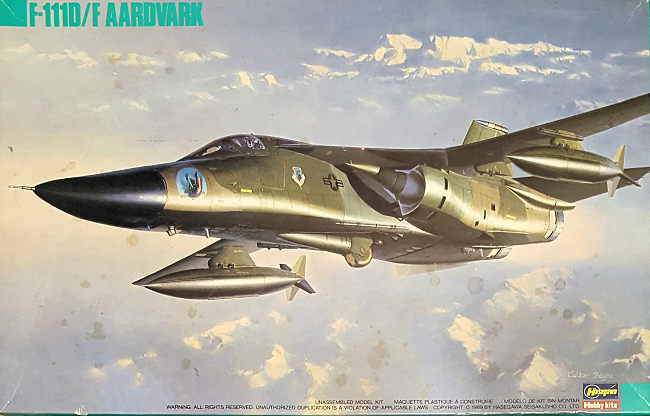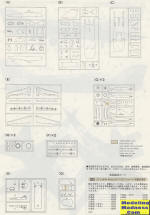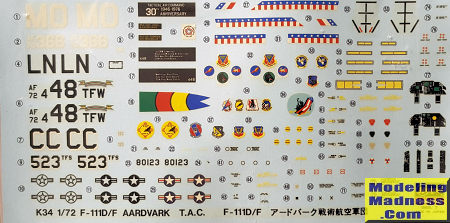
Hasegawa 1/72 F-111D/F Aardvark
|
KIT # |
4034 (K 34) |
|
PRICE: |
$30.00 when new |
|
DECALS: |
Three aircraft |
|
REVIEWER: |
|
|
NOTES: |
1989 release. 170 parts. |

|
HISTORY |
Originally known as the TFX (Tactical Fighter "X"), the F-111 was conceived to meet a USAF requirement for a new tactical fighter-bomber. In 1960, the Department of Defense combined the USAF's requirement with a Navy need for a new air superiority fighter, then launched a competition among aircraft manufacturers for the final design. In 1962, General Dynamics and Boeing were selected as finalists with the General Dynamics TFX design eventually winning out. The Navy version was known as the F-111B and the USAF version the F-111A. The first flight of the F-111A took place in December 1964, and the first production models were delivered to the USAF in 1967. Meanwhile, the Navy's F-111B program was canceled as it didn't meet the needs of the Navy being too large and too complex a system for carrier operations. This only goes to show that a 'one plane does all' deal isn't always the best. Interestingly, during all of this there was an aircraft that met and in many cases exceeded the requirements of the USN, USAF and USMC; the F-4 Phantom II.
In all, 562 F-111s of all series were built; 159 of them were preproduction and production F-111As. Many of the F-111As were rebuilt as EF-111As and those were the final type retired in 1996, the A models having been sent to the boneyard at least a decade earlier. The last operator was Australia where their special-built F-111Cs were joined by ex SAC FB-111As that were converted to F-111Gs. The RAAF retired the type in 2010.
|
THE KIT |
As you can expect, it is superbly molded with no flash or sink areas that I
could spot right away. There are some ejector pin marks on some of the
smaller pieces that will have to be dealt with. Typical of Hase 1/72 kits,
the cockpit instrument panels and side consoles are decals. The canopy
cannot be displayed in the open positions, but the plastic is very clear so
the interior can easily be seen. The rather complex intake shapes are well
done as is the equally complicated main gear bay.
The wings can only be displayed in the forward position as the slats and
flaps will prevent them from being swept back. The fuselage opening is also
not large enough to permit this. There are no missiles or bombs included
but there are large drop tanks and some other missile that I believe is a
Durandel included along with a MER so you can fill the pylons. A gun pod is
also provided for the centerline.
Instructions are superb and
provide Gunze paint references as well as general and FS color references.
Markings are provided for three aircraft. Two of them are F-111Fs and there is
one F-111D. The F-111Ds
 Back
in the late 1980s,Hasegawa produced the entire series of F-111s and also
produced some Limited Edition boxings (actually just decal switches). These seem
to have pretty well disappeared from store shelves and catalogues, though they
can still be found.
Back
in the late 1980s,Hasegawa produced the entire series of F-111s and also
produced some Limited Edition boxings (actually just decal switches). These seem
to have pretty well disappeared from store shelves and catalogues, though they
can still be found. were all operated by the 27th TFW at Canon AFB out in
the sticks of New Mexico. This version carries the centerline mounted gun. The
first F option has the Pave Tack FLIR/Laser designator pod and is the boss bird
of the 48th TFW based at Lakenheath in the UK. The other is just a standard F
model based at Mountain Home AFB in Idaho. All three are in the black belly SEA
camouflage scheme. The decals are well past the 'use by' date, though you might
still be able to use them despite the yellowing. Fortunately there are
aftermarket.
were all operated by the 27th TFW at Canon AFB out in
the sticks of New Mexico. This version carries the centerline mounted gun. The
first F option has the Pave Tack FLIR/Laser designator pod and is the boss bird
of the 48th TFW based at Lakenheath in the UK. The other is just a standard F
model based at Mountain Home AFB in Idaho. All three are in the black belly SEA
camouflage scheme. The decals are well past the 'use by' date, though you might
still be able to use them despite the yellowing. Fortunately there are
aftermarket.
|
CONCLUSIONS |
In 1/72, the F-111 has been modeled by Airfix, ESCI and Hasegawa. The ESCI kit can be found in AMT and Italeri boxes, but the Hasegawa kit is still the best on the market. Its lack of availability has escalated the price into the $75.00 plus range so some fairly intense searching will be needed to find one for less. As a note, Hobby 2000 has released the reboxed Hasegawa kit, but at an even higher price. If you find one, you'll discover that it will be a fiddly construct as are most modern Hasegawa multi-mode kits, but the end results will be most pleasing.
September 2021
Copyright ModelingMadness.com. All rights reserved. No reproduction in part or in whole without express permission.
If you would like your product reviewed fairly and fairly quickly, please contact the editor or see other details in the Note to Contributors.